HubSpot Marketing discusses the importance of buyer personas in marketing. Buyer personas increase website traffic, attract high-value visitors, and improve email conversions. They anticipate issues faster and form better connections with potential buyers. The steps of creating a buyer persona include determining the number of personas, conducting internal research, performing market research, and conducting customer interviews. Also, give names to personas to make them look real. Then create a visual aid that’s easy to share and understand.
Snapps courses are now available
How to scale a service business:
- Improve services and apply customer feedback
- Define your ideal customer
- Build a strong team
- Automate your operations
- Implement effective marketing strategies
- Set your pricing
- Prioritize customer experience
- Monitor key metrics
You must scale a service business to achieve long-term success. Improve the quality of your services to serve more clients. Receiving feedback for improvement and solving customer needs leads to higher profit. According to Bain and Company, brands achieve 4-8% revenue growth when delivering great customer experience. Focus on employee training and retention to deliver efficient customer experience. Teach an employee from the ground up before giving them more work you’re accustomed to doing. Give them feedback to meet quality standards.

Now that technology plays a crucial role in business, automate as many processes as possible. This makes scaling easier and faster. According to a McKinsey study, businesses have a 30% increase in operational efficiency when integrating automation into customer service. Using technology is more affordable than hiring different people. Narrow the focus of your selected niche when scaling the business. Choose a narrow product range and establish your brand in one segment or product. Then franchise your service business in other geographic regions.
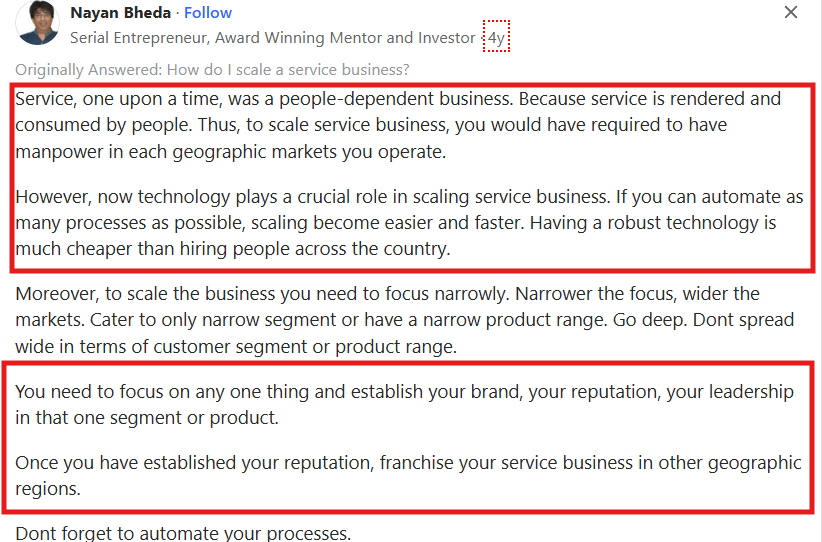
In this article, we discuss steps to scale a service business. We mention common challenges such as handling a growing team, financial management, and maintaining service quality.
1. Focus on improvement
Here’s how to improve your service business:
- Invest in employee training and development - This results in higher job satisfaction, engagement, and retention.
- Outline work procedure - Focus on outlining every step of work procedure with pictures. A team member must do the procedure with only the directions as a guide.
- Provide video tutorials - These are more effective than written procedures. Attach the video training to a series of short checklists to have the best training system.
- Build customer satisfaction - Prioritize improving service delivery, customer support, and communication. Satisfied customers will post positive feedback and refer your services to others.


A Redditor mentioned that good service speaks for itself. They worked with a home cleaning service that paid strong attention to detail and care. The cleaning service organized items, left detailed notes about their services, and provided tips for maintenance.

The technical team can send thank-you notes to show customer appreciation. It should be simple and infrequent to make the stone-hearted people smile. Find the challenges of using live chat programs and the problems you’re trying to solve.

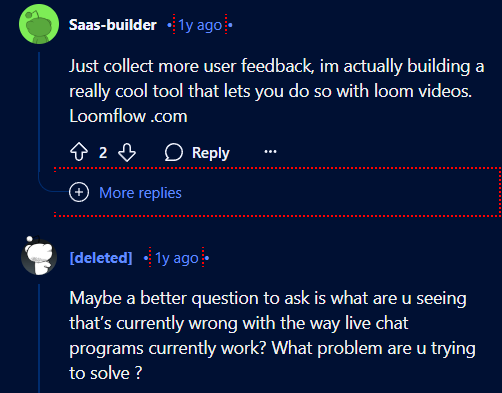
2. Define your ideal customer
Here’s how to research your Ideal Customer Profile (ICP):
- Analyze your existing customers - Determine your profitable customers or the ones who have the longest relationships with your company. Then start looking for common characteristics like their company size, the type of industry they’re in, and job title.
- Use ChatGPT - A creative way to know your ideal customers. Create a document after generating the list of results of your ICP. Refine the list to 2-3 options, then do your research. Find out what these people do every day, how their success is measured, their career paths, where they hang out online, and the influential people they look up to. Do this before asking, “What are my target audience’s pain points?”
- Conduct market research - Create surveys or start in-depth interviews with potential customers. This helps you understand their needs and preferences.
- Communicate with your customer service team - Collect their feedback or insights regarding their interactions with customers. Ask frequent questions they get or the biggest challenges customers face.


3. Build a strong team
Here’s how to build a strong team:
- Define your needs - Identify your specific targets for market share, revenue, and customer base. Identify skill gaps where your team members need support.
- Structure your team - Define the roles and responsibilities of your members. Explore various team structures as matrix, functional, and divisional structures. Choose people who share the same vision as you. They don’t need to entirely agree with your vision. But they need to understand that your vision is workable.
- Start with freelancers - Find them on Fiverr and LinkedIn. In this way, you can stay on your budget and get things done.
- Give adequate training - Invest in training programs to enhance the skills of your team. Always encourage open communication to build trust.
- Focus on equity - Do this when finding the right people to do the job. Reach out to them with an equity offer for future partnerships. Try not to low ball potential members.



Having a strong team results from a successful service business. Your team makes sure that the quality of your services remains consistent, especially with increased demand. You’ll need more tasks, more projects, and more clients when scaling a business. So, it’s important to have a reliable team to handle workload without causing burnout.

Caya gave insights on finding the ideal team for a startup. The ideal team is divided into three: the business person, tech person, and marketing/sales person. Approach the recruitment process like dating and begin with casual conversations. Start with a problem statement instead of a specific solution. Then consider long-term compatibility and be open to feedback.
4. Automate your operations
Here’s how to automate your business operations:
- Create standard operating procedures (SOPs) - These are for onboarding clients and delivering services. SOPs are important for smoothly transitioning to the growth stage of your business. Have a solid documentation of processes to make training and onboarding easier. Lack of proper documentation can lead to serious issues.
- Select the right tools - Use customer relationship management (CRM) systems to track customer interactions and automate sales processes. Also, use Slack to effectively communicate with team members.
- Implement automation strategically - Train your team in using new automation tools. Pay attention to automating tasks that have the biggest contribution on customer satisfaction and efficiency.

Automating operations maintain the consistency, efficiency, and scalability of your service business. Standardized processes make sure that clients get the same level of services. Having a good system reduces errors and tasks are completed faster.

Greg Hickman posted systems that systematized his service-based business. A sales system is a well-documented process for sales conversations. This includes a consultative close formula. It increases the possibility of enrolling new clients and maintains consistency. A marketing system collects information using lead magnets, video sales letters, and webinars. The retention, resell, or upsell system keeps existing clients. Lastly, the traffic system comprises organic traffic, paid traffic, and partner traffic.
5. Implement effective marketing strategies
Below are effective marketing strategies:
- Social media - Reach specific interests, demographics, and behaviors. Regularly post content and communicate with potential clients in comment sections. Instagram and TikTok tell your brand story through engaging visuals.
- SEO - Use SEO tools to rank your site higher on search engines. Target specific keywords that users would usually search for. SEO provides a high return on investment (ROI) and drives organic traffic to your site.
- Paid ads - Deliver immediate traffic to your website. You have 100% control over your advertising budget and continuously monitor your campaigns.
- Blog posts - Publish high-quality content on your website. Discuss topics related to your niche or industry to boost audience engagement. Add keywords to prioritize SEO and online visibility.
- Local partnerships - A great way to open new opportunities. Partner with influencers and affiliates to implement referral programs and expand your reach. Work with industry leaders and other businesses to expand product or service offerings.
Applying effective marketing strategies is beneficial for a service business. You’ll need to reach a larger audience as you scale your business. Marketing brings brand awareness and generates qualified leads. Marketing campaigns increase conversions to achieve revenue targets.
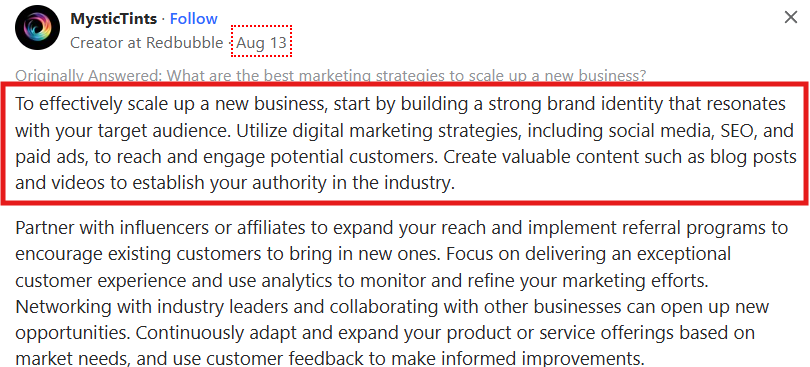

Adam Erhart discussed the elements of an effective marketing strategy for service-based businesses. The CASE (Coaches and consultants, Agencies, Service professionals, and Experts) funnel comprises several stages. The traffic stage attracts potential customers through various channels. The opt-in stage gives valuable content for a user’s contact information. The authority amplifier stage offers a short training to build expertise. The application stage uses a form to pre-qualify prospects. Calendar bookings encourage users to schedule a call, and sales calls discuss attainable goals in using your services.
6. Set your pricing
Here’s how to set your pricing when scaling a service business:
- Understand your costs - Calculate expenses on labor, materials, and subcontractors. Also compute indirect costs like rent, marketing, administrative expenses, and utilities.
- Analyze your competitors - The best way to get a price idea for your service business is to check the pricing of competitors. Determine what makes your service better to justify a higher price. Depending on what you offer, offer reasonable pricing and better service.
- Select a pricing strategy - Set the costs based on the value you deliver to clients. Increased efficiency and cost savings determine the pricing plans for your services. Provide various service packages tailored to clients’ budgets and needs.
- Consider your target market - Know how much your customers are willing to purchase your services. Clearly explain to them the value you provide and mention the incentives they can receive.
Setting the right pricing will motivate customers in trying your services. Operational costs enlarge with marketing, hiring, and infrastructure. Your pricing should cover these costs to make sure your business remains profitable. Adequate pricing leads to the sustainability and long-term financial health of your business.

A Quora user mentioned that it’s hard to increase prices to paying clients. You risk inspiring them to choose alternative providers that are more affordable. Research what your market will pay for your service based on value. Plan your service portfolio over time to meet the various needs of each market.
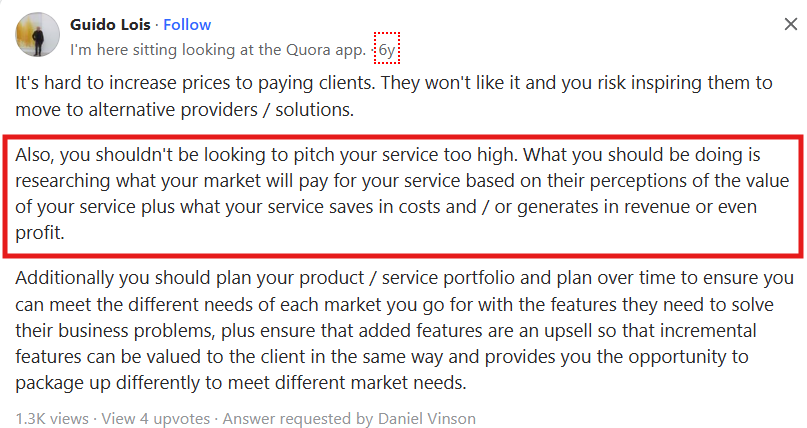
Another Quora mentioned that a service should cover costs and profit. It’s a different pricing strategy than pricing a product. An individual has the potential to negotiate for a discount. Come up with a reasonable cost for your service based on equivalent services.
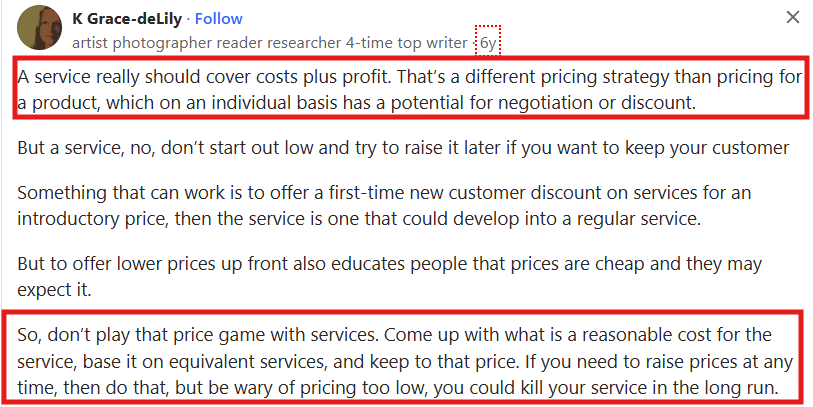
7. Prioritize customer experience
Here’s how to prioritize customer experience while offering the best services:
- Understand your customer journey - Pinpoint areas where clients can experience frustration. Find ways to improve interactions and increase repeat customers.
- Invest in technology - Use tools like HubSpot CRM, Zoho CRM, and Salesforce Lighting. These track customer feedback, preferences, and interactions.
- Give excellent customer support - Publish informative content like FAQs, blogs, and tutorials to answer common questions from users. Teach your support team to be attentive, patient, empathetic, and solution-oriented.
- Collect feedback - Have a customer ID in your ecosystem to collect reviews. Find dissatisfied customers and come up with a service recovery strategy for them. If you have loyal customers, give them retention bonuses to keep buying your services. Communication is the key to knowing how to address negative feedback. Not communicating with a client about an issue is the biggest miss in service delivery.
A Redditor suggested having a customer ID in your ecosystem for feedback . Find dissatisfied customers and come up with a service recovery strategy for them. If you have loyal customers, give them retention bonuses to keep buying your services. Communication is the key to knowing how to address negative feedback. Not communicating with a client about an issue is the biggest miss in service delivery.
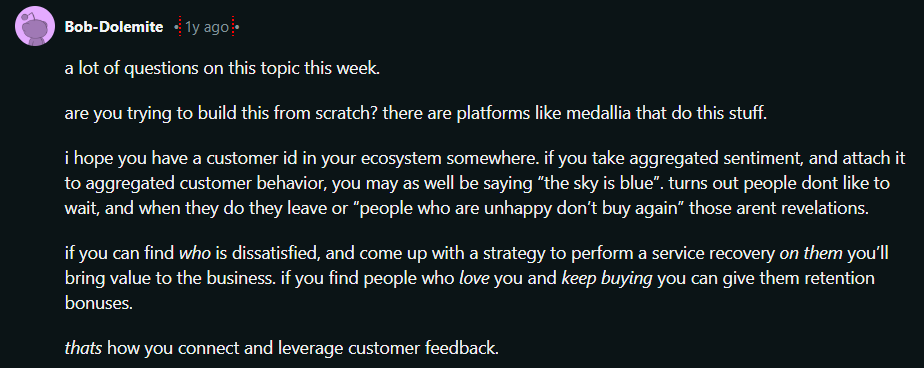

Improving customer experience is the backbone of a successful business. Every customer should receive a consistent and satisfying experience in trying your services. A poor user experience leads to customer dissatisfaction. Frustrated customers will most likely leave negative reviews on your website.
8. Monitor key metrics
Here’s how to monitor website metrics for your service business:
- Define your goals - Do you prioritize driving online sales, generating sales, or boosting brand awareness? Your goals determine the right metrics to track.
- Identify specific metrics - Track unique visitors, bounce rates, and new visitors for website traffic. Measure conversion rates and click-through rates (CTRs) for engagement metrics. Lastly, track consumer behavior through exit pages, popular pages, and returning visitors.
- Select website analytics tools - Use Google Search Console to manage your web performance in search results. Google Analytics is a famous tool for providing comprehensive website data.
- Set up tracking - Customize reports to visualize metrics that are successful or those that need improvement. To collect data, tracking codes must be installed on your website.
- Regularly monitor - Review your website metrics during a specific week or month. Identify patterns and trends in your data to understand your website performance.
Monitoring key metrics leave valuable insights about your business operations. Checking metrics pinpoints challenges to address them before they negatively impact your growth. Make informed decisions about staffing, resource allocation, and marketing strategies.
A Redditor suggested focusing on tracking customer acquisition cost (CAC) and customer retention rates. They help you acquire and keep old customers. Cash flow and revenue growth are early metrics for understanding financial health. Tracking customer feedback and satisfaction offer invaluable insights. It refines offerings to make sure they resonate with your target audience. Focus less on detailed financial ratios and more on basic profitability indicators.


What Are the Common Challenges in Building and Scaling a Service Business?
- Handling a growing team - Onboarding qualified members is important to deliver services. Preserving primary values is difficult, especially if each team member is different. It’s essential to prioritize clear communication and openness of thoughts or opinions.
- Financial management - Managing efficient cash flow becomes challenging with longer payment cycles. So, it’s crucial to determine the right pricing strategy that generates profit while remaining competitive.
- Maintaining service quality - Focus on regular feedback mechanisms and quality control measures. It’s difficult to address individual customer needs and maintain personalized services. Your team should implement CRM systems to analyze customer needs or preferences.
- Scalability of the business model - Document best practices and determine areas that need improvement. Use technology to enhance communication and automate tasks for scaling.
- Customer retention - This requires effective sales and marketing strategies. Build genuine relationships with clients and foster loyalty. Give excellent customer service and incentives to boost retention or referrals.
Can Appointment Bookings Help Scale a Service business?
Yes,
appointment bookings help scale a service business. Automated booking systems reduce taking phone calls, email management, and manual scheduling. They prevent scheduling conflicts or double-bookings to immediately address customer needs. Clients can visit your website to book appointments without waiting for business hours. Having a website makes it flexible for users to schedule online using any device. Also, send automated reminders to clients about appointment schedules and announcements.
Can a Website Builder Scale a Service Business?
Yes, a website builder can scale a service business. Having a professional and flexible website increases credibility. Use customization options for features like service descriptions, portfolio, testimonials, and online bookings. Website builders have SEO tools to rank your site on search engines. Add relevant keywords on blogs to build trust for users. Include an image gallery to display successful projects and interactions with happy customers. The
best website builders for service business have analytics tools to track website performance.
What is the Best Website Builder for Scaling a Service Business?
The best website builder for scaling a service business is Snapps.ai. Its AI and SEO tools enhance blog content to rank your site on search engines. Customize pages like appointment bookings, testimonials, pricing plans, service descriptions, and client portals. Use widgets such as calendar scheduling, contact form, and live chat. These widgets convert high-quality leads into paying customers. Snapps’ personalization rules improve navigation links, notification bars, and pop-ups. These rules notify customers about bookings and events.
Recent Articles
Our Support Heroes Are Here For You
Don’t waste time on tedious manual tasks. Let Automation do it for you. Simplify workflows, reduce errors, and save time for solving more important problems.



